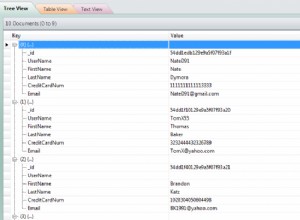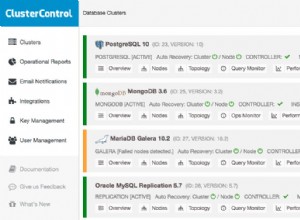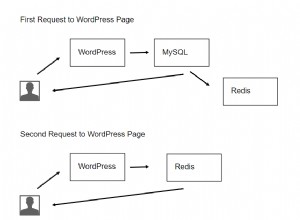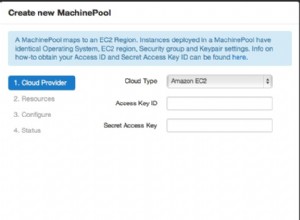Abaixo está um exemplo simples para dar uma ideia de como é fácil usar algumas das estruturas de dados avançadas do Redis - neste caso, Listas do Redis:O código-fonte completo deste exemplo pode ser visualizado on-line
using var redisClient = new RedisClient();
//Create a 'strongly-typed' API that makes all Redis Value operations to apply against Shippers
IRedisTypedClient<Shipper> redis = redisClient.As<Shipper>();
//Redis lists implement IList<T> while Redis sets implement ICollection<T>
var currentShippers = redis.Lists["urn:shippers:current"];
var prospectiveShippers = redis.Lists["urn:shippers:prospective"];
currentShippers.Add(
new Shipper {
Id = redis.GetNextSequence(),
CompanyName = "Trains R Us",
DateCreated = DateTime.UtcNow,
ShipperType = ShipperType.Trains,
UniqueRef = Guid.NewGuid()
});
currentShippers.Add(
new Shipper {
Id = redis.GetNextSequence(),
CompanyName = "Planes R Us",
DateCreated = DateTime.UtcNow,
ShipperType = ShipperType.Planes,
UniqueRef = Guid.NewGuid()
});
var lameShipper = new Shipper {
Id = redis.GetNextSequence(),
CompanyName = "We do everything!",
DateCreated = DateTime.UtcNow,
ShipperType = ShipperType.All,
UniqueRef = Guid.NewGuid()
};
currentShippers.Add(lameShipper);
Dump("ADDED 3 SHIPPERS:", currentShippers);
currentShippers.Remove(lameShipper);
Dump("REMOVED 1:", currentShippers);
prospectiveShippers.Add(
new Shipper {
Id = redis.GetNextSequence(),
CompanyName = "Trucks R Us",
DateCreated = DateTime.UtcNow,
ShipperType = ShipperType.Automobiles,
UniqueRef = Guid.NewGuid()
});
Dump("ADDED A PROSPECTIVE SHIPPER:", prospectiveShippers);
redis.PopAndPushBetweenLists(prospectiveShippers, currentShippers);
Dump("CURRENT SHIPPERS AFTER POP n' PUSH:", currentShippers);
Dump("PROSPECTIVE SHIPPERS AFTER POP n' PUSH:", prospectiveShippers);
var poppedShipper = redis.PopFromList(currentShippers);
Dump("POPPED a SHIPPER:", poppedShipper);
Dump("CURRENT SHIPPERS AFTER POP:", currentShippers);
//reset sequence and delete all lists
redis.SetSequence(0);
redis.Remove(currentShippers, prospectiveShippers);
Dump("DELETING CURRENT AND PROSPECTIVE SHIPPERS:", currentShippers);
EXEMPLO DE SAÍDA:
ADDED 3 SHIPPERS:
Id:1,CompanyName:Trains R Us,ShipperType:Trains,DateCreated:2010-01-31T11:53:37.7169323Z,UniqueRef:d17c5db0415b44b2ac5da7b6ebd780f5
Id:2,CompanyName:Planes R Us,ShipperType:Planes,DateCreated:2010-01-31T11:53:37.799937Z,UniqueRef:e02a73191f4b4e7a9c44eef5b5965d06
Id:3,CompanyName:We do everything!,ShipperType:All,DateCreated:2010-01-31T11:53:37.8009371Z,UniqueRef:d0c249bbbaf84da39fc4afde1b34e332
REMOVED 1:
Id:1,CompanyName:Trains R Us,ShipperType:Trains,DateCreated:2010-01-31T11:53:37.7169323Z,UniqueRef:d17c5db0415b44b2ac5da7b6ebd780f5
Id:2,CompanyName:Planes R Us,ShipperType:Planes,DateCreated:2010-01-31T11:53:37.799937Z,UniqueRef:e02a73191f4b4e7a9c44eef5b5965d06
ADDED A PROSPECTIVE SHIPPER:
Id:4,CompanyName:Trucks R Us,ShipperType:Automobiles,DateCreated:2010-01-31T11:53:37.8539401Z,UniqueRef:67d7d4947ebc4b0ba5c4d42f5d903bec
CURRENT SHIPPERS AFTER POP n' PUSH:
Id:4,CompanyName:Trucks R Us,ShipperType:Automobiles,DateCreated:2010-01-31T11:53:37.8539401Z,UniqueRef:67d7d4947ebc4b0ba5c4d42f5d903bec
Id:1,CompanyName:Trains R Us,ShipperType:Trains,DateCreated:2010-01-31T11:53:37.7169323Z,UniqueRef:d17c5db0415b44b2ac5da7b6ebd780f5
Id:2,CompanyName:Planes R Us,ShipperType:Planes,DateCreated:2010-01-31T11:53:37.799937Z,UniqueRef:e02a73191f4b4e7a9c44eef5b5965d06
PROSPECTIVE SHIPPERS AFTER POP n' PUSH:
POPPED a SHIPPER:
Id:2,CompanyName:Planes R Us,ShipperType:Planes,DateCreated:2010-01-31T11:53:37.799937Z,UniqueRef:e02a73191f4b4e7a9c44eef5b5965d06
CURRENT SHIPPERS AFTER POP:
Id:4,CompanyName:Trucks R Us,ShipperType:Automobiles,DateCreated:2010-01-31T11:53:37.8539401Z,UniqueRef:67d7d4947ebc4b0ba5c4d42f5d903bec
Id:1,CompanyName:Trains R Us,ShipperType:Trains,DateCreated:2010-01-31T11:53:37.7169323Z,UniqueRef:d17c5db0415b44b2ac5da7b6ebd780f5
DELETING CURRENT AND PROSPECTIVE SHIPPERS:
Mais exemplos estão disponíveis na [página de exemplos do RedisExamples Redis] e no conjunto de testes abrangente
Velocidade #
Uma das melhores coisas do Redis é a velocidade - é rápida.
Este exemplo abaixo armazena e obtém todo o banco de dados Northwind (3202 registros) em menos 1,2 segundos - nunca tivemos isso tão rápido!
(Executando dentro de um teste de unidade VS.NET/R# em um iMac de 3 anos)
using var client = new RedisClient();
var before = DateTime.Now;
client.StoreAll(NorthwindData.Categories);
client.StoreAll(NorthwindData.Customers);
client.StoreAll(NorthwindData.Employees);
client.StoreAll(NorthwindData.Shippers);
client.StoreAll(NorthwindData.Orders);
client.StoreAll(NorthwindData.Products);
client.StoreAll(NorthwindData.OrderDetails);
client.StoreAll(NorthwindData.CustomerCustomerDemos);
client.StoreAll(NorthwindData.Regions);
client.StoreAll(NorthwindData.Territories);
client.StoreAll(NorthwindData.EmployeeTerritories);
Console.WriteLine("Took {0}ms to store the entire Northwind database ({1} records)",
(DateTime.Now - before).TotalMilliseconds, totalRecords);
before = DateTime.Now;
var categories = client.GetAll<Category>();
var customers = client.GetAll<Customer>();
var employees = client.GetAll<Employee>();
var shippers = client.GetAll<Shipper>();
var orders = client.GetAll<Order>();
var products = client.GetAll<Product>();
var orderDetails = client.GetAll<OrderDetail>();
var customerCustomerDemos = client.GetAll<CustomerCustomerDemo>();
var regions = client.GetAll<Region>();
var territories = client.GetAll<Territory>();
var employeeTerritories = client.GetAll<EmployeeTerritory>();
Console.WriteLine("Took {0}ms to get the entire Northwind database ({1} records)",
(DateTime.Now - before).TotalMilliseconds, totalRecords);
/*
== EXAMPLE OUTPUT ==
Took 1020.0583ms to store the entire Northwind database (3202 records)
Took 132.0076ms to get the entire Northwind database (3202 records)
*/
Observação:o tempo total gasto inclui uma operação Redis extra para cada registro para armazenar o id em um conjunto Redis para cada tipo, bem como serializar e desserializar cada registro usando o TypeSerializer do Service Stack.
Operações Lex #
As novas operações de conjuntos ordenados ZRANGEBYLEX que permitem consultar um conjunto ordenado lexicalmente foram adicionadas. Uma boa vitrine para isso está disponível em autocomplete.redis.io.
Essas novas operações estão disponíveis como um mapeamento 1:1 com redis-server em
IRedisNativeClient :public interface IRedisNativeClient
{
...
byte[][] ZRangeByLex(string setId, string min, string max, int? skip, int? take);
long ZLexCount(string setId, string min, string max);
long ZRemRangeByLex(string setId, string min, string max);
}
E as APIs mais fáceis de usar em
IRedisClient :public interface IRedisClient
{
...
List<string> SearchSortedSet(string setId, string start=null, string end=null);
long SearchSortedSetCount(string setId, string start=null, string end=null);
long RemoveRangeFromSortedSetBySearch(string setId, string start=null, string end=null);
}
Assim como os correspondentes de versão do NuGet, o Redis usa
[ char para expressar inclusão e ( char para exclusividade. Como o IRedisClient APIs padrão para pesquisas inclusivas, essas duas APIs são as mesmas:Redis.SearchSortedSetCount("zset", "a", "c")
Redis.SearchSortedSetCount("zset", "[a", "[c")
Alternativamente, você pode especificar um ou ambos os limites como exclusivos usando o
( prefixo, por exemplo:Redis.SearchSortedSetCount("zset", "a", "(c")
Redis.SearchSortedSetCount("zset", "(a", "(c")
Mais exemplos de API estão disponíveis em LexTests.cs.
API HyperLog #
O ramo de desenvolvimento do servidor Redis (disponível quando a v3.0 for lançada) inclui um algoritmo engenhoso para aproximar os elementos únicos em um conjunto com a máxima eficiência de espaço e tempo. Para obter detalhes sobre como funciona, consulte o blog do criador do Redis, Salvatore, que explica em detalhes. Essencialmente, ele permite que você mantenha uma maneira eficiente de contar e mesclar elementos exclusivos em um conjunto sem precisar armazenar seus elementos. Um exemplo simples disso em ação:
redis.AddToHyperLog("set1", "a", "b", "c");
redis.AddToHyperLog("set1", "c", "d");
var count = redis.CountHyperLog("set1"); //4
redis.AddToHyperLog("set2", "c", "d", "e", "f");
redis.MergeHyperLogs("mergedset", "set1", "set2");
var mergeCount = redis.CountHyperLog("mergedset"); //6
Verificar APIs #
O Redis v2.8 introduziu uma bela nova operação SCAN que fornece uma estratégia ideal para percorrer um conjunto de chaves inteiro de uma instância redis em partes de tamanho gerenciável utilizando apenas um cursor do lado do cliente e sem introduzir nenhum estado de servidor. É uma alternativa de maior desempenho e deve ser usada em vez de KEYS no código do aplicativo. SCAN e suas operações relacionadas para atravessar membros de Sets, Sorted Sets e Hashes agora estão disponíveis no Redis Client nas seguintes APIs:
public interface IRedisClient
{
...
IEnumerable<string> ScanAllKeys(string pattern = null, int pageSize = 1000);
IEnumerable<string> ScanAllSetItems(string setId, string pattern = null, int pageSize = 1000);
IEnumerable<KeyValuePair<string, double>> ScanAllSortedSetItems(string setId, string pattern = null, int pageSize = 1000);
IEnumerable<KeyValuePair<string, string>> ScanAllHashEntries(string hashId, string pattern = null, int pageSize = 1000);
}
public interface IRedisClientAsync
{
IAsyncEnumerable<string> ScanAllKeysAsync(string pattern = null, int pageSize, CancellationToken ct);
IAsyncEnumerable<string> ScanAllSetItemsAsync(string setId, string pattern = null, int pageSize, CancellationToken ct);
IAsyncEnumerable<KeyValuePair<string, double>> ScanAllSortedSetItemsAsync(string setId, string pattern = null, int pageSize, ct);
IAsyncEnumerable<KeyValuePair<string, string>> ScanAllHashEntriesAsync(string hashId, string pattern = null, int pageSize, ct);
}
//Low-level API
public interface IRedisNativeClient
{
...
ScanResult Scan(ulong cursor, int count = 10, string match = null);
ScanResult SScan(string setId, ulong cursor, int count = 10, string match = null);
ScanResult ZScan(string setId, ulong cursor, int count = 10, string match = null);
ScanResult HScan(string hashId, ulong cursor, int count = 10, string match = null);
}
public interface IRedisNativeClientAsync
{
ValueTask<ScanResult> ScanAsync(ulong cursor, int count = 10, string match = null, CancellationToken ct);
ValueTask<ScanResult> SScanAsync(string setId, ulong cursor, int count = 10, string match = null, CancellationToken ct);
ValueTask<ScanResult> ZScanAsync(string setId, ulong cursor, int count = 10, string match = null, CancellationToken ct);
ValueTask<ScanResult> HScanAsync(string hashId, ulong cursor, int count = 10, string match = null, CancellationToken ct);
}
O
IRedisClient fornece uma API de nível superior que abstrai o cursor do cliente para expor uma sequência Enumerable lenta para fornecer uma maneira ideal de transmitir resultados verificados que se integram perfeitamente ao LINQ, por exemplo:var scanUsers = Redis.ScanAllKeys("urn:User:*");
var sampleUsers = scanUsers.Take(10000).ToList(); //Stop after retrieving 10000 user keys




